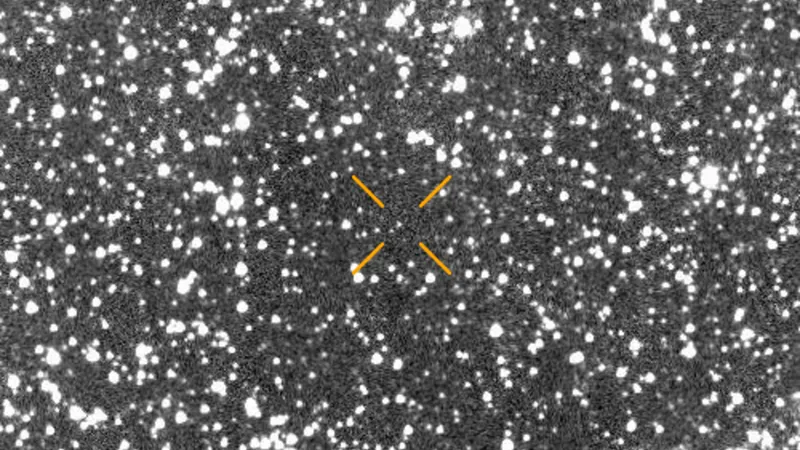
Meet 3I/ATLAS: Our Mysterious Interstellar Visitor Zooming Through the Solar System
2025-07-10
Author: Noah
A Cosmic Intruder on a Fast Track to Nowhere
The solar system has welcomed an intriguing new guest: 3I/ATLAS, an interstellar visitor speeding through our cosmic neighborhood on a one-way journey. Discovered on July 1, it's only the third of its kind ever recorded, raising questions about its origins and nature.
This remarkable object, likely a comet, is racing towards us at an astonishing speed of over 130,000 mph (210,000 km/h) and is set to come closest to the sun in late October before continuing its trek back into interstellar space.
What Exactly Are Interstellar Objects?
Interstellar objects (ISOs) are celestial entities that originate outside the sun’s gravitational influence. This includes asteroids and comets that have been captured by our solar system; however, spotting them is a challenge.
Currently, only two ISOs have been confirmed—1I/'Oumuamua, discovered in 2017, and 2I/Borisov, spotted in 2019. Astronomers believe many more ISOs exist but remain hidden from our view.
The Discovery of 3I/ATLAS
3I/ATLAS was first spotted through data collected by the Asteroid Terrestrial-impact Last Alert System (ATLAS), which monitors the night sky using telescopes in Hawaii, Chile, and South Africa. Initially labeled A11pl3Z, it was quickly confirmed to be an ISO using pre-existing data.
A team of over 40 researchers combined their insights to publish their findings, emphasizing collaboration to gather maximum information on this fleeting visitor.
First Impressions: What Do We Know About 3I/ATLAS?
Initially thought to be an asteroid, further observations revealed features typical of a comet, such as a bright halo of gas and ice known as a coma, and a tail. The estimated size of 3I/ATLAS’s coma could reach 15 miles (24 kilometers) across.
Unlike its predecessors, 3I/ATLAS travels faster and on a unique path, approaching our sun perpendicularly compared to the past ISOs.
Is 3I/ATLAS a Threat to Earth?
When discovered, 3I/ATLAS was approximately 4.5 astronomical units (AU) from the sun, and it will make its closest approach to the sun on October 30, coming within 1.5 AU. Closer to December, it will safely pass Earth at a minimum distance of 1.6 AU—meaning no threat whatsoever!
As it draws nearer to the sun, it will become brighter, offering an opportunity for stargazers to catch a glimpse.
Tracing Its Origins: Where Did 3I/ATLAS Come From?
Theories suggest that 3I/ATLAS likely hails from the Milky Way's thick disk, a region housing two-thirds of our galaxy’s stars. However, pinpointing its exact origin requires more data.
Extraterrestrial Theories?
Speculations about potential links to extraterrestrial civilizations have surrounded previous ISOs, but 3I/ATLAS appears to behave like a standard comet, dampening those theories.
The Quest for Exploration: Can We Reach 3I/ATLAS?
While we’ve successfully sent missions to other celestial objects, currently, there are no plans or technology to visit 3I/ATLAS. Funding issues further diminish the chances of such an expedition.
Get Ready for More Cosmic Visitors!
Experts believe that interstellar objects will become more common as our detection methods improve, particularly with advancements like the Vera C. Rubin Observatory.
We could witness the next ISO in as little as a year, unlocking secrets about distant star systems and the planets within them—each new discovery offering a glimpse into the cosmos!









 Brasil (PT)
Brasil (PT)
 Canada (EN)
Canada (EN)
 Chile (ES)
Chile (ES)
 Česko (CS)
Česko (CS)
 대한민국 (KO)
대한민국 (KO)
 España (ES)
España (ES)
 France (FR)
France (FR)
 Hong Kong (EN)
Hong Kong (EN)
 Italia (IT)
Italia (IT)
 日本 (JA)
日本 (JA)
 Magyarország (HU)
Magyarország (HU)
 Norge (NO)
Norge (NO)
 Polska (PL)
Polska (PL)
 Schweiz (DE)
Schweiz (DE)
 Singapore (EN)
Singapore (EN)
 Sverige (SV)
Sverige (SV)
 Suomi (FI)
Suomi (FI)
 Türkiye (TR)
Türkiye (TR)
 الإمارات العربية المتحدة (AR)
الإمارات العربية المتحدة (AR)